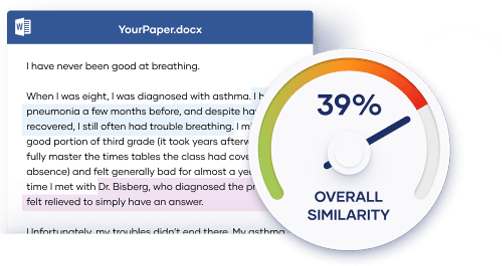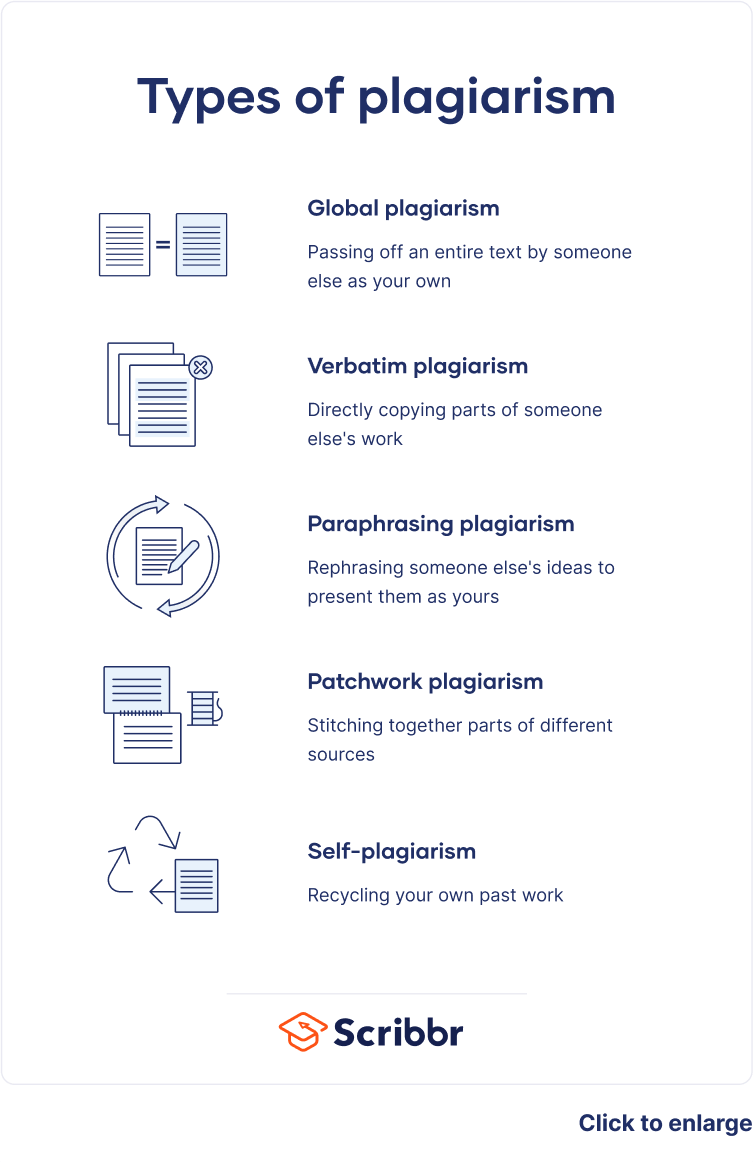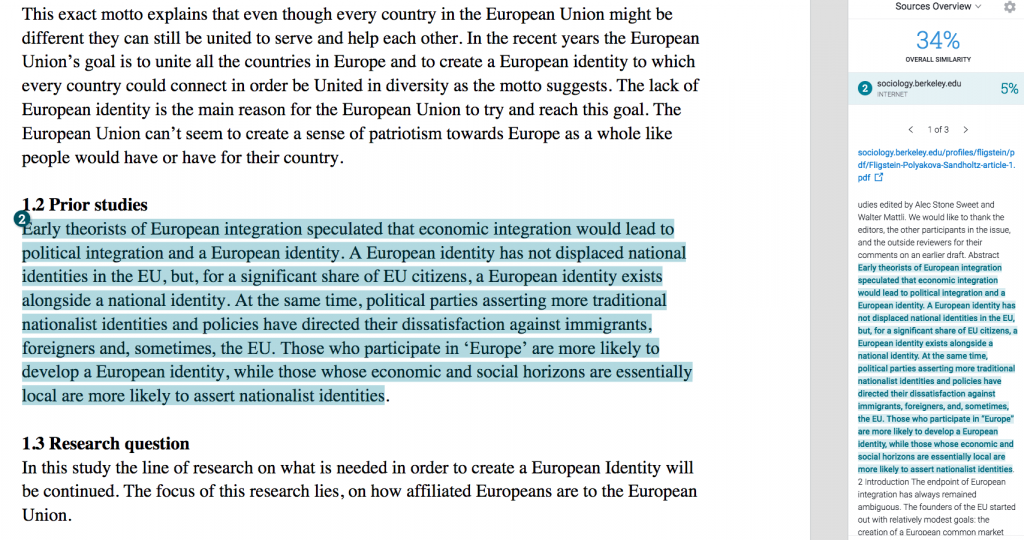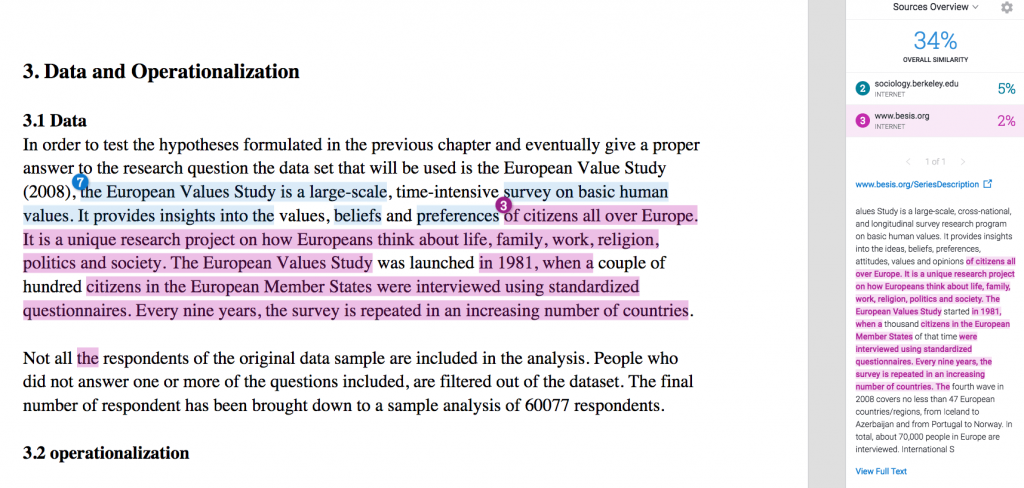The 5 Types of Plagiarism | Explanations & Examples
Plagiarism comes in many forms, some more severe than others—from rephrasing someone’s ideas without acknowledgement to stealing a whole essay. These are the five most common types of plagiarism:
- Global plagiarism means passing off an entire text by someone else as your own work.
- Verbatim plagiarism means directly copying someone else’s words.
- Paraphrasing plagiarism means rephrasing someone else’s ideas to present them as your own.
- Patchwork plagiarism means stitching together parts of different sources to create your text.
- Self-plagiarism means recycling your own past work.
Except for global plagiarism, these types of plagiarism are often accidental, resulting from failure to understand how to properly quote, paraphrase, and cite your sources. If you’re concerned about accidental plagiarism, a plagiarism checker, like the one from Scribbr, can help.
Global plagiarism: Plagiarising an entire text
Global plagiarism means taking an entire work by someone else and passing it off as your own.
For example, if you get someone else to write an essay or assignment for you, or if you find a text online and submit it as your own work, you are committing global plagiarism.
Because it involves deliberately and directly lying about the authorship of a work, this is one of the most serious types of plagiarism, and it can have severe consequences.
Avoiding this kind of plagiarism is straightforward: just write your own essays!
Verbatim plagiarism: Copying words directly
Verbatim plagiarism, also called direct plagiarism, means copying and pasting someone else’s words into your own work without attribution.
This could be text that’s completely identical to the original or slightly altered. If the structure and the majority of the words are the same as in the original, this counts as verbatim plagiarism, even if you delete or change a couple of words.
In academic writing, you can and should refer to the words of others. To avoid verbatim plagiarism, you just need to quote the original source by putting the copied text in quotation marks and including an in-text citation. You can use the free Scribbr Citation Generator to create correctly formatted citations in MLA or APA Style.
Generate accurate citations with Scribbr
Most plagiarism checkers can easily detect verbatim plagiarism.
Example of verbatim plagiarism
Paraphrasing plagiarism: Rephrasing ideas
Paraphrasing means rephrasing a piece of text in your own words. Paraphrasing without citation is the most common type of plagiarism.
Paraphrasing, like quoting, is a legitimate way to incorporate the ideas of others into your writing. It only becomes plagiarism when you rewrite a source’s points as if they were your own. To avoid plagiarism when paraphrasing, cite your sources just as you would when quoting.
If you translate a piece of text from another language without citation, this is also a type of paraphrasing plagiarism. Translated text should always be cited; you’re still using someone else’s ideas, even if they’re in a different language.
Example of paraphrasing
| Original (Cronon, 1995) |
|
|---|---|
| ‘Thus the past came to occupy a prominent place in Romanticism. The Romantic thinkers, however, had little affinity with historical schemes such as Condorcet’s. A linear and rational progression in history was the last thing they considered important. For them, the richness of the past lay in its otherness and strangeness rather than in what predictably preceded the here and now, in a distant era like the Middle Ages or antiquity rather than in the cursed, prosaic Enlightenment that preceded it. Such remote, distinct periods were usually manifestations of a golden age that had ended, but to which one could return with the aid of the imagination …’ | Romantic thinkers were fascinated with the past, but they rarely adopted a linear viewpoint on historical progress. Rather than the rational Enlightenment period, Romanticism is imaginatively preoccupied with the more distant and thus more enchantingly alien past: the Middle Ages and the ancient world. |
| Original (Cronon, 1995) |
|
|---|---|
| ‘Thus the past came to occupy a prominent place in Romanticism. The Romantic thinkers, however, had little affinity with historical schemes such as Condorcet’s. A linear and rational progression in history was the last thing they considered important. For them, the richness of the past lay in its otherness and strangeness rather than in what predictably preceded the here and now, in a distant era like the Middle Ages or antiquity rather than in the cursed, prosaic Enlightenment that preceded it. Such remote, distinct periods were usually manifestations of a golden age that had ended, but to which one could return with the aid of the imagination …’ | Romantic thinkers were fascinated with the past, but they rarely adopted a linear viewpoint on historical progress. Rather than the rational Enlightenment period, Romanticism is imaginatively preoccupied with the more distant and thus more enchantingly alien past: the Middle Ages and the ancient world (Doorman, 2003, p. 45). |
Patchwork plagiarism: Stitching together sources
Patchwork plagiarism, also called mosaic plagiarism, means copying phrases, passages, and ideas from different sources and putting them together to create a new text.
This can include slightly rephrasing passages while keeping many of the same words and much of the same structure as the original, and inserting your own words here and there to stitch the plagiarised text together. Make sure to cite your sources whenever you quote or paraphrase to avoid plagiarism.
This type of plagiarism requires a little more effort and is more insidious than just copying and pasting from a source, but plagiarism checkers can still easily detect it.
Example of patchwork plagiarism
Self-plagiarism: Plagiarising your own work
Self-plagiarism means reusing work that you’ve previously submitted or published. It amounts to academic dishonesty to present a paper or a piece of data as brand new when you’ve already gotten credit for the work.
The most serious form of self-plagiarism is to turn in a paper you already submitted for a grade to another class. Unless you have explicit permission to do so, this is always considered self-plagiarism.
Self-plagiarism can also occur when you reuse ideas, phrases or data from your previous assignments. Reworking old ideas and passages is not plagiarism as long as you have permission to do so and you cite your previous work to make their origins clear.
Scribbr’s Self-Plagiarism Checker
Online plagiarism scanners don’t have access to internal university databases and therefore can’t check your document for self-plagiarism.
Using Scribbr’s Self-Plagiarism Checker, you can upload your previous work and compare it to your current document. The checker will scan the texts for similarities and flag any passages where you might have self-plagiarized.
Frequently asked questions about plagiarism
Cite this Scribbr article
If you want to cite this source, you can copy and paste the citation or click the ‘Cite this Scribbr article’ button to automatically add the citation to our free Reference Generator.
Streefkerk, R. (2024, October 18). The 5 Types of Plagiarism | Explanations & Examples. Scribbr. Retrieved 30 December 2025, from https://www.scribbr.co.uk/preventing-plagiarism/types-of-plagiarism/



